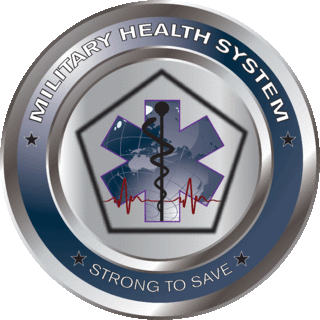
Medicare is a government national health insurance program in the United States, begun in 1965 under the Social Security Administration (SSA) and now administered by the Centers for Medicare and Medicaid Services (CMS). It primarily provides health insurance for Americans aged 65 and older, but also for some younger people with disability status as determined by the SSA, including people with end stage renal disease and amyotrophic lateral sclerosis.
Dual-eligible beneficiaries refers to those qualifying for both Medicare and Medicaid benefits. In the United States, approximately 9.2 million people are eligible for "dual" status. Dual-eligibles make up 14% of Medicaid enrollment, yet they are responsible for approximately 36% of Medicaid expenditures. Similarly, duals total 20% of Medicare enrollment, and spend 31% of Medicare dollars. Dual-eligibles are often in poorer health and require more care compared with other Medicare and Medicaid beneficiaries.

The Defense Criminal Investigative Service (DCIS) is the criminal investigative arm of the Office of Inspector General, U.S. Department of Defense. DCIS protects military personnel by investigating cases of fraud, bribery, and corruption; preventing the illegal transfer of sensitive defense technologies to proscribed nations and criminal elements; investigating companies that use defective, substandard, or counterfeit parts in weapon systems and equipment utilized by the military; and stopping cyber crimes and computer intrusions.

The United States Navy Reserve (USNR), known as the United States Naval Reserve from 1915 to 2005, is the Reserve Component (RC) of the United States Navy. Members of the Navy Reserve, called Reservists, are categorized as being in either the Selected Reserve (SELRES), the Training and Administration of the Reserve (TAR), the Individual Ready Reserve (IRR), or the Retired Reserve.

The Dwight D. Eisenhower Army Medical Center (EAMC) is a 93-bed medical treatment facility located on Fort Eisenhower, GA, located near Augusta, Georgia that previously served as the headquarters of the Army's Southeast Regional Medical Command (SERMC). SERMC oversaw the Army's hospitals and clinics within the southeastern United States and Puerto Rico. SERMC was renamed Southern Regional Medical Command (SRMC) and was relocated to San Antonio in 2009.

A United States Uniformed Services Privilege and Identification Card is an identity document issued by the United States Department of Defense to identify a person as a member of the Armed Forces or a member's dependent, such as a child or spouse.
Wisconsin Physicians Service Insurance Corporation (WPS Health Solutions) is a not-for-profit service insurance corporation based in Madison, Wisconsin. WPS offers health insurance plans for groups and individuals and benefit plan administration for businesses. WPS also provides insurance claims processing services under various U.S. government contracts and has a subsidiary corporation, EPIC Specialty Benefits, offering dental and other nonmedical benefits.
Title 10 of the United States Code outlines the role of armed forces. It provides the legal basis for the roles, missions and organization of each of the services as well as the United States Department of Defense. Each of the five subtitles deals with a separate aspect or component of the armed services.
TriWest Healthcare Alliance is a Phoenix, Arizona based corporation that manages health benefits under the United States Department of Veterans Affairs (VA) VAPCCC program in Regions 3, 5, and 6. On October 1, 2018, TriWest's contract for VAPCCC was expanded to cover Regions 1, 2, and 4.
The Extended Care Health Option or ECHO is a supplemental coverage program offered by TRICARE to dependents of members of the uniformed services of the United States with a qualifying disability.
Military psychiatry covers special aspects of psychiatry and mental disorders within the military context. The aim of military psychiatry is to keep as many serving personnel as possible fit for duty and to treat those disabled by psychiatric conditions. Military psychiatry encompasses counseling individuals and families on a variety of life issues, often from the standpoint of life strategy counseling, as well as counseling for mental health issues, substance abuse prevention and substance abuse treatment; and where called for, medical treatment for biologically based mental illness, among other elements.
Medicare Advantage is a capitated program for providing Medicare benefits in the United States. Under Part C, Medicare pays a sponsor a fixed payment. The sponsor then pays for the health care expenses of enrollees. Sponsors are allowed to vary the benefits from those provided by Medicare's Parts A and B as long as they provide the actuarial equivalent of those programs. The sponsors vary from primarily integrated health delivery systems to unions to other types of non profit charities to insurance companies. The largest sponsor is a hybrid: the non profit charity AARP using UnitedHealth.

The Military Health System (MHS) is a form of nationalized health care operated within the United States Department of Defense that provides health care to active duty, Reserve component and retired U.S. Military personnel and their dependents.
The Uniformed Services Benefit Association (USBA) is a nonprofit organization headquartered in Overland Park, Kansas, providing affordable group life insurance plans and other financial services specifically designed for active duty and retired military members and their families, as well as honorably discharged veterans, National Guard and Reserve members, and federal civilian employees.
Defense Enrollment Eligibility Reporting System (DEERS) is a computerized database for United States Service members, military retirees, 100% VA Disabled Veterans, dependents, DoD active Contractors, and others worldwide who are entitled to Public Key Infrastructure and TRICARE eligibility.
The US Family Health Plan (USFHP) is a U.S. Department of Defense-sponsored healthcare plan that serves military family members exclusively. US Family Health Plan operates in six regions, sixteen states, including the District of Columbia.
The Empowering Patients First Act is legislation sponsored by Rep. Tom Price, first introduced as H.R. 3400 in the 111th Congress. The bill was initially intended to be a Republican alternative to the America's Affordable Health Choices Act of 2009, but has since been positioned as a potential replacement to the Patient Protection and Affordable Care Act (PPACA). The bill was introduced in the 112th Congress as H.R. 3000, and in the 113th Congress as H.R. 2300. As of October 2014, the bill has 58 cosponsors. An identical version of the bill has been introduced in the Senate by Senator John McCain as S. 1851.
AHLTA is a global Electronic Health Record (EHR) system used by U.S. Department of Defense (DoD). It was implemented at Army, Navy and Air Force Military Treatment Facilities (MTF) around the world between January 2003 and January 2006. It is a services-wide medical and dental information management system. What made AHLTA unique was its implementation date, its Central Data Repository, its use in operational medicine and its global implementation. There is nothing like it in the private sector.
Health care finance in the United States discusses how Americans obtain and pay for their healthcare, and why U.S. healthcare costs are the highest in the world based on various measures.

The Defense Health Agency (DHA) is a joint, integrated combat support agency that enables the U.S. Army, U.S. Navy, and U.S. Air Force medical services to provide a medically ready force and ready medical force to Combatant Commands in both peacetime and wartime. The DHA is in charge of integrating clinical and business operations across the MHS and facilitates the delivery of integrated and reasonably priced health care to MHS clients.







